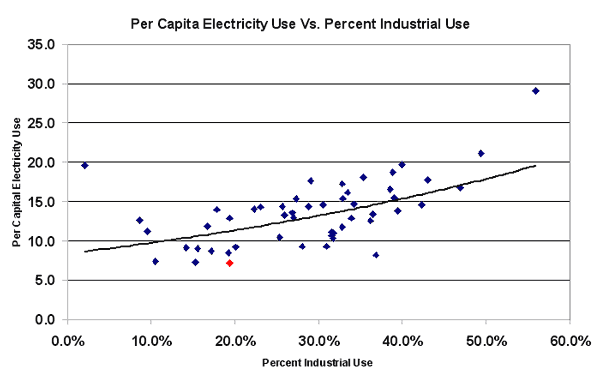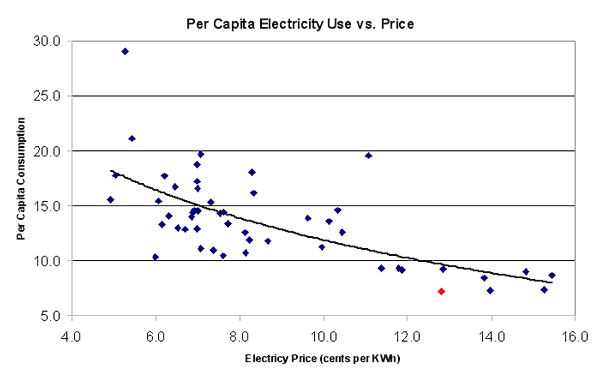Is There a Zero-Cost Regulatory Solution to Energy Efficiency?
A while back, I criticized a story in the NY Times, as quoted by Kevin Drum, that said that California had among the lowest per capita electricity usage of any state (true) and that this was because of the intelligent regulation regime in the state (yes, but not the way they meant). The implication of Drum's argument was that there was some sort of efficiency ideal that a smart group of technocrats could reach at limited cost to the state (false). Specifically, Drum argued:
Anyway, it's a good article, and goes to show the kinds of things we
could be doing nationwide if conservative politicians could put their
Chicken Little campaign contributors on hold for a few minutes and take
a look at how it's possible to cut energy use dramatically "” and reduce
our dependence on foreign suppliers "” without ruining the economy. The
energy industry might not like the idea, but the rest of us would.
My response, in part, was this:
Well, here are the eight states in the data set above that the
California CEC shows as having the lowest per capita electricity use:
CA, RI, NY, HI, NH, AK, VT, MA. All right, now here are the eight
states from the same data set that have the highest electricity prices: CA, RI, NY, HI, NH, AK, VT, MA. Woah! It's the exact same eight states! The 8 states with the highest prices are the eight states with the lowest per capita consumption.
Unbelievable. No way that could have an effect, huh? It must be all
those green building codes in CA. I suspect Drum is sort of right,
just not in the way he means. Stupid regulation in each state drives
up prices, which in turn provides incentives for lower demand. It
achieves the goal, I guess, but very inefficiently. A straight tax
would be much more efficient.
As part of a presentation I am working on about global warming and proposed California CO2 abatement bill AB52, I had the occasion to do a bit more research. All of my data is from the Energy Information Administration, whose page URLs keep changing and thus breaking my links but this index page to data seems to stay the same.
I found three factors that seem to be the main drivers of state electricity demand (which is measured in all of the charts below in thousands of kw-h per capita). The first factor is climate, and certainly California has one of the milder climates. The chart below looks at residential electricity demand vs. cooling degree days (weighted for population location). Each data point is a state, with California is shown as the red data point:
We get something similar for heating degree days, with electrical use going down as the climate gets milder, though not as good of a fit, which is not surprising since electricity is less important to heating than cooling. Since California is well below the line, mild climate can be said to explain some of its lead on other states, but not all.
So I looked next at the percentage of electricity demand that goes to industry. More heavily industrialized states will have a higher total per capita demand, because heavy industry chews up electricity that other types of businesses do not. It turns out that California has a relatively low industrial use, which is not surprising given the regulatory environment there and the degree to which industry has been chased out of the state (one would have to be a madman to, all things considered, set up a new factory in California). So here is the same type of chart of total electrical per capita use by state vs. the % industrial demand, again with each data point a state and California in red:
Again there is a pretty strong relationship, and again we see some but not all of California's low per capita consumption explained. In effect, states on the left have exported their high-electricity-use industries to the states on the right (or to other countries).
I have saved the most obvious relationship for last: price. It turns out unsurprisingly that the states with the highest electricity prices have the lowest per capital consumption:
Rolling climate, industrial intensity, and price together, these factors seem to explain at least 80% of California's efficiency lead over other states. California government regulatory policy does indeed drive lower electrical consumption, just not exactly the way they would like you to think. By chasing industries out of the state and raising electricity costs above those of almost every other state, California has reached a lower per capita consumption level.
